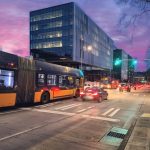A new study shows a preservative in car tires is responsible for collapsing Coho salmon runs, adding new urgency to efforts to reduce the number of cars on the road.
Faint glows dot the side of office towers as raindrops fall upon the ground below. After a long summer, it’s starting to rain again in Seattle. The scent of musky petrichor fills the air, an aura we feel but cannot see. Cars rush along the street and off into the fog; a little stream begins form along the roadbed as the rain drizzles harder. A leaf that latches onto the current and flows down the storm drain.
There always seems to be a certain amount of gloom that accompanies winter in the Pacific Northwest. The sun barely rises, the clouds never go away, and the rain is omnipresent. But ask a fellow Cascadian about the weather and they’ll probably tell you that they don’t mind it. Indeed, the skies may be gloomy, but we’ve managed to make it—and nature itself—a part of our identity.
Seattle wouldn’t be itself without its natural environment; the forests, orcas, and salmon that surround the city are some of its most defining icons. The last one, though, isn’t doing too hot: up to 90% of Coho salmon migrating up some Pacific Northwest streams were suddenly dying just before they spawned, and for decades no one knew for certain why.
But according to recently-released research from Science magazine, the hidden killer was right in front of our eyes: car tires. Put simply, car tires are made up of compounds with bonds that can be broken by ozone (a gas created when car pollutants react with sunlight). To protect those bonds, automakers provision their tires with a chemical additive called 6PPD that reacts with ozone before it can interact with (and break down) the tire bonds.
And that’s where the problem is: when 6PPD reacts with ozone, it creates a substance called 6PPD-quinone that’s toxic to Coho salmon–and likely not great for other aquatic life either. As cars hit the road, their tire dust is scattered onto roadways and swept into streams by our frequent rainfall; when salmon swallow the contaminated water, they suffocate. Other wildlife could be critically impacted too.
The problem isn’t specific to just the Puget Sound, either; 6PPD is used to make 3.1 million tires annually all around the world. In fact, 6PPD is just one of the many particulate matter (PM) emissions created from tire, brake, clutch, and road wear. The Organization for Economic Cooperation and Development (OECD) estimates that exposure to ambient PM caused 4.2 million premature deaths in 2015; PM 2.5 particles (particles with diameters less than 2.5 micrometers) are especially dangerous since they can get breathed deep into the lungs.
The OECD also noted that, while electric cars emit fewer exhaust emissions than regular cars, they emit the same amount of non-exhaust emissions—if not more. The OECD predicts that a transition to electric cars in California will drive up non-exhaust PM 2.5 and PM 10 until at least 2035. A 2016 study agrees: battery-powered cars emit virtually the same amount of PM 2.5 and PM 10 emissions as their gas-powered counterparts. Don’t believe it? Think of it this way: an electric Tesla Model 3 is almost exactly the same size as a gas Toyota Corolla but weighs over 1,000 pounds more because of its battery. Since tire and road wear is directly proportional to weight, the reduction Tesla has in exhaust PM emissions is counteracted by an increase in non-exhaust PM emissions. Lower energy costs could encourage people to drive more, and the data even assumes that EVs have no brake wear thanks to regenerative braking—which may exaggerate the benefit.
While the moral of the story isn’t that electric cars are worse than gas cars (they’re not), it is an indication that EVs won’t be the end-all-be-all they’re purported to be: even though they’ll curb greenhouse gas emissions, they’ll still emit a plethora of toxins that are hazardous to both humans and wildlife. Anti-pedestrian planning, sprawl, congestion, crashes would all still be a thing with EVs, not to mention the physical and sociological tolls of a life shackled to the automobile–with all the stress and noise that entails.
The EV tax credit
The fight against auto-centrism has a simple goal: to break our dependency on cars and reduce their quantity on our streets, especially in our most transit-rich cities. And that hinges on getting people to not buy them. Much of our world is so car-oriented that owning one is quite literally a necessity and changing that will inevitably take a while. There are, however, a few very simple things we could do to speed things up.
The first thing we could do is simple: end the plug-in hybrid electric vehicle (PHEV) tax credit. PHEVs are hybrid cars (think Prius) that can also be plugged in to charge their batteries. Most PHEVs can do about 10 to 20 miles on electric power only, so in theory they could satisfy most Americans’ commutes without any gas—so long as they’re plugged in at the end of the day.
Spoiler alert: they aren’t being plugged in regularly. Back when the US government bought a fleet of PHEVs, the cars didn’t even come close to achieving their predicted fuel economy numbers since almost no one plugged them in. Transport & Environment too found just a few months ago that PHEVs average two-and-a-half-times the pollution they are officially estimated. The fallacy is that many PHEVs come with a $5,000+ tax credit but end up polluting more than traditional hybrids which don’t. PHEVs work on paper, but so does trickle-down economics; in a perfect world, the government shouldn’t be rewarding people to buy new cars, especially ones that still pollute.
That applies to fully-electric vehicles (EVs) too—many which qualify for the full $7,500 credit are some of the most expensive vehicles on market like the $150,000 Porsche race car and $80,000 Audi SUV—vehicles whose buyers should have no business claiming what is essentially free cash. Meanwhile, some of the most affordable EVs like the Tesla Model 3 and Chevy hatchback have no tax credit at all (and EV buyers in general are much richer than the average American). So in essence EV credits are like giving rich people a pat on the back for being rich. Ain’t that swell.
The EV tax credit is estimated to cost $4 billion dollars from 2019 to 2028 (though fossil fuels got $650 billion in 2015 along, oops!)—an insane amount of money that can and should be spent in better places. An e-bike credit, for example, makes much more fiscal and environmental sense. It costs half as much to save one kilogram of carbon dioxide when that money is spent on an e-bike boost rather than an electric car subsidy. It makes sense: e-bikes are far more affordable than cars (even the top-end models undercut the cheapest cars by thousands) and use less energy to run. Still, they’re too expensive to be something most people could just go out and buy, especially if those people already bear the costs of owning a car.
The thing is, e-bikes are perfect for most people since over 60% of car trips in the US are shorter than six miles. That’s well within the range (and speed) of an e-bike. Longer journeys could be made by riding the bike to a park-and-ride and taking the bus; smaller e-bikes could even be brought along on board. There’s also e-cargo bikes that can handle the school run and weekly Costco haul.
Plus, imagine how much extra space we’d have everywhere if private cars turned into bicycles and more trips happened on transit: a single car lane could turn into two bike lanes, and a typical car parking garage could store thousands of bicycles (or be torn down altogether). Streets themselves could finally be restored into the open shared spaces they once were.
Though, for prudence, we could temporarily keep the EV tax credit (still ditching the PHEV one), but set a 4,000 pound weight cap and a $40,000 price cap. That way, smaller, more popular EV models remain affordable to those who need them while luxury cars and SUVs won’t be subsidized.
Speaking of SUVs…
SUVs are the epitome of the automobile. In the modern day and age, SUVs have become less of the off-road warriors they once were and have become more like souped-up hatchbacks with all-wheel-drive. Automakers may portray them to be an “adventurous” way to connect with the outdoors, but statistically we know that the most “off-road” modern SUVs will ever go is the mall parking lot.

The case against SUVs is simple because they provide no substantial benefit to its drivers and are at the same time inefficient, heavy, and dangerous. Heck, even driving enthusiasts hate them. Recently, the auto industry has even gotten into making really tiny SUV “crossovers” for “Urban Adventure” (yes, it’s actually capitalized)—again, why? Driving an SUV in the city is an oxymoron. No matter their size, they get worse fuel economy than their normal-sized counterparts, and yet most of them shockingly seat the same number of people. Here’s a helpful list of questions to help decide whether or not an SUV is essential:
- Do you need more space than a sedan? Get a hatchback/wagon.
- Do you need to carry extra people? Get a minivan.
- Do you need a “tall driving position”? You don’t, because that’s what makes an SUV two to three times more likely to kill a pedestrian.
- Do you want an SUV to look cool? Not likely to work. Climate denial is going out of style.
- Do you live where it snows a lot? SUVs are actually more dangerous in the snow except in a crash (more on this below).
- Are you actually a giant and not fit in a normal car? Okay, you might need an SUV if you can’t get by with other modes.
Perhaps the only place where SUVs are objectively better is when they collide with a smaller car, since their weight and height would do a better job protecting its occupants (at the expense of those in the other car). But this problem would go away if everyone just drove regular cars, not to mention that SUVs are more likely to crash in the first place since they’re harder to stop and easier to roll over.
Did I mention that heavier cars emit a lot more PM emissions? SUVs are much heavier—something our lungs cannot afford. The PM study from earlier specifically encouraged the “weight reduction of all vehicles to significantly reduce PM emissions from traffic”.
Indeed, fighting against climate change will necessitate more walking, biking, and riding transit*. I’ll digress that many people will still need cars to get around, but SUVs are wholly unnecessary. Banning them, at least in cities, should be a priority in ending our love affair with the automobile.
Salmon have thrived in the Pacific Northwest for thousands of years, and have sustained countless generations of indigenous people (who centered their culture around them) and newcomers. The salmon don’t live around us; we live around them. The nature that shapes our identity disappearing—will we be there to save it?
*Yes, bikes and buses still have rubber tires with 6PPD, but bikes are infinitesimally lighter than cars and buses have a much higher capacity. Both will spew out significantly fewer PM emissions per person.
Brandon Zuo is a high schooler and enjoys reading about urban planning and transportation. They enjoy exploring the city on the bus and on their bike. They believe that income and racial equality should be at the forefront of urban development. Brandon Zuo formerly wrote under the pseudonym Hyra Zhang.


